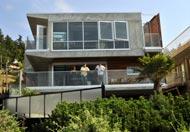Environmental footprint
Lafarge is committed to reducing the environmental impact of its businesses by reducing greenhouse gas emissions, saving energy, optimizing management of resources, etc. The objective is to produce more and better while using less.
Challenge #1: reducing our product’s environmental footprint |
|
|
The cement industry generates around 5% of the world's CO2 emissions. In relation to its Cement business, Lafarge is committed to reducing its environmental impact using 3 levers:
|

Lafarge glossaryFly ash, slag, clinker, industrial ecology, CO2, granular stacking, additives, etc. See the glossary for all technical terms. |
For energy efficiency |
|
|
|
Alain Vassal, sustainable construction director, Bouygues Construction: "The major challenge of sustainable construction is not only the energy efficiency of buildings, it is also the reduction of emissions during the manufacturing of concrete. Bouygues Construction and Lafarge are working on a joint project to develop low-carbon concretes."
|
Optimized formulation for concretes |
|

|
Nicolas Roussel, researcher at thePonts et Chaussées central laboratory (LCPC): |
Our solutions to this challenge

The ductility of Ductal®, a high added-value concrete, gives it exceptional capacities for stretching, extending, bowing and twisting.
Also very resistant to corrosion, abrasion and impacts, Ductal® has a lifespan 2 to 3 times longer than traditional concrete.

Plasterboard now meets the most diverse technical and aesthetic requirements. Whether painted or tiled, interior or exterior - their characteristics mean they comply with the requirements of sustainable construction:
|
La Plura® demonstrates higher-than-average solidity and mechanical resistance.

By replacing more and more of the clinker (the basic component of cement which requires physicochemical transformation at high temperatures ) with naturally or industrially sourced cement additives, Lafarge has created a new generation of low-carbon cements reducing the environmental footprint of the Group's products.

Designed and developed in North America, DuraclimeTM is economical in energy. Its special composition (specific additives and bonding agents) means it can be produced at lower temperatures than traditional asphalt. Less energy is consumed to heat the product. Less greenhouse gases are released and there are no unpleasant fumes.
Another advantage is that the particular viscosity of DuraclimeTM allows a higher proportion of recycled aggregates to be added and makes the roads and sidewalks produced using it exceptionally hard-wearing.

The water resistant qualities of concrete are often praised. However, Lafarge has just developed a new draining concrete which retains the mechanical properties of traditional concrete. This innovation was made possible by advances in nanotechnology.
This new concrete is well suited to the construction of large surface areas in an urban environment such as parking lots and storage areas.
It is effective at:
- absorbing rainwater quickly in the event of heavy rain,
- reducing the risk of flooding in the area
- safely channeling the water into the groundwater table.

The formulation of Thermedia® 0.6 B concrete is completely innovative. It is made using very lightweight aggregates, 40% less dense than traditional aggregates. This composition cuts its thermal conductivity by "two-thirds" compared with standard concrete, while retaining identical structural properties to traditional concrete. Thermedia® 0.6 B encourages a reduction in thermal losses through the building's envelope and it contributes to improving construction methods using external thermal insulation.





